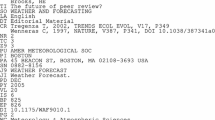Abstract
In this paper, we analyze in a quantitative manner the changing position of Physical Review in the global field of physics, compared to other important physics journals, since the beginning of the twentieth century. This approach complements existing intellectual and institutional accounts of Physical Review’s historical evolution and offers a dynamical portrait of the global landscape of physics journals, based on a bibliometric analysis of the relations between journals obtained through co-citation analysis. The co-citation networks constructed for successive twenty-year periods provide a measure of the rising position of Physical Review from the periphery to the center of physics. The intellectual content of the journal, with its evolving topics and most influential authors, is also analyzed using the bibliographical references contained in all its articles.








Similar content being viewed by others
References
Tom Siegfried, “Top 10 from Physical Review’s First 125 Years,” Science News, February 8, 2018.
For statistics regarding the most cited papers in the first 110 volumes of Physical Review, see: Sidney Redner, “Citation Statistics from 110 Years of Physical Review,” Physics Today 58, no. 6 (2005), 49–54. For a chronology of seminal papers published through the 125 years of the Physical Review, see: https://journals.aps.org/125years/2017-physical-review-materials.
See Paul Hartmann, A Memoir on The Physical Review: A History of the First Hundred Years (New York: American Institute of Physics, 1994); Henry Stroke, The Physical Review: The First Hundred Years (New York: Springer, 1999).
For a description of the co-citation analysis method, see: Henry Small, “Co-Citation in the Scientific Literature: A New Measure of the Relationship between Two Documents,” Journal of the American Society for Information Science 24, no. 4 (1973), 265–69.
Ken Chevren, Mastering Gephi Network Visualization (Birmingham: Packt Publishing, 2015).
Lewis Pyenson, “Physical Sense in Relativity: Max Planck Edits the Annalen der Physik, 1906–1918,” Annalen der Physik 17, no. 2–3 (2008), 167–89.
Yves Gingras, “The Transformation of Physics from 1900 to 1945,” Physics in Perspective 12, no. 3 (2010), 248–65; Paul Forman, John Heilbron and Spencer Weart, “Physics circa 1900: Personnel, Funding, and Productivity of the Academic Establishments,” Historical Studies in the Physical Sciences 5 (1975), 1–185.
Roberto Lalli, “‘Dirty Work’, But Someone Has to Do It: Howard P. Robertson and the Refereeing Practices of Physical Review in the 1930s,” Notes and Records of the Royal Society of London 70, no. 2 (2016), 151–74, on 155.
John H. Van Vleck, cited in Anthony Duncan, Michel Janssen, “On the Verge of Umdeutung in Minnesota: Van Vleck and the Correspondence Principle,” pt. 1, Archive for the History of Exact Sciences 61, no. 6 (2007), 553–624, on 566.
Duncan and Janssen, “On the Verge of Umdeutung” (ref. 9), 567.
See: “The Nobel Prize in Physics 1925,” NobelPrize.org, accessed January 3, 2019, https://www.nobelprize.org/prizes/physics/1925/summary/.
The centrality of an author is defined by the sum of all links that connect his or her node with other nodes of the network. The more a node is connected with other nodes the more central it is in the network.
Alfred O. C. Nier and John H. Van Vleck, “John Torrence Tate, 1889–1950,” Biographical Memoirs of the National Academy of Science 47 (1975), 450–84, on 471.
Melinda Baldwin, “‘Keeping in the Race’: Physics, Publication Speed and National Publishing Strategies in Nature, 1895–1939,” British Journal for the History of Science 27, no. 2 (2014), 257–79.
Roberto Lalli, “‘Dirty Work,’” (ref. 8), 156.
David C. Cassidy, “Physics in the United States during the 1930s,” in The 1930s: The Reality and the Promise, ed. J. Bret Bennington, Zenia Sacks DaSilva, Michael D’Innocenzo, and Stanislao G. Pugliese, 365–74 (Cambridge: Cambridge Scholars Publishing, 2016), 365–66. See also Daniel J. Kevles, The Physicists: The History of a Scientific Community in Modern America (New York: Alfred Knopf, 1977).
Roberto Lalli, “A New Scientific Journal Takes the Scene: The Birth of Reviews of Modern Physics,” Annalen der Physik 526, no. 9–10 (2014), A83–A87.
Roberto Lalli, “‘Dirty Work,’” (ref. 8), 156.
Joseph D. Martin, Solid Foundations: Structuring American Solid State Physics, 1939–1993 (PhD Thesis: University of Minnesota, 2013), 135–36.
Daniel Kennefick, “Einstein versus the Physical Review,” Physics Today 58, no. 9 (2005), 43–48.
Roger H. Stuewer, The Age of Innocence: Nuclear Physics between the First and Second World Wars (Oxford: Oxford University Press, 2018).
Robert K. Adair, “Essay: Physical Review Letters; Sam Goudsmit’s Vision,” Physical Review Letters 100, January 18, 2008, https://journals.aps.org/prl/edannounce/PhysRevLett.100.020001.
Harriett Zuckerman and Robert K. Merton, “Patterns of Evaluation in Science: Institutionalization, Structure and Functions of the Referee System,” Minerva 9, no. 1 (1970), 66–100, on 80.
David Kaiser, “Booms, Busts, and the World of Ideas: Enrollment Pressures and the Challenge of Specialization,” Osiris 27 (2012), 276–302, on 291–92.
Lalli, “Dirty Work” (ref. 8), 168.
Kaiser, “Booms, Busts” (ref. 24), 292.
Kaiser, “Booms, Busts” (ref. 24), 292.
Kaiser, “Booms, Busts” (ref. 24), 297.
“The Nobel Prize in Physics 1963,” NobelPrize.org, accessed January 3, 2019, https://www.nobelprize.org/prizes/physics/1963/summary/.
Joseph D. Martin, “What’s in a Name Change?: Solid State Physics, Condensed Matter Physics, and Materials Science,” Physics in Perspective 17, no. 1 (2015), 9.
To take into account the presence of many countries in the same paper, we fractionate their contributions: a paper with authors from three different countries is thus attributed one third to each country.
Author information
Authors and Affiliations
Corresponding author
Additional information
Publisher's Note
Springer Nature remains neutral with regard to jurisdictional claims in published maps and institutional affiliations.
Mahdi Khelfaoui is a Social Science and Humanities Research Council Postdoctoral Fellow at the University of Ottawa and a member of the Centre Interuniversitaire de Recherche sur la Science et la Technologie. Yves Gingras is Canada Research Chair in History and Sociology of Science and Professor in the Department of History at the Université du Québec à Montréal.
Rights and permissions
About this article
Cite this article
Khelfaoui, M., Gingras, Y. Physical Review: From the Periphery to the Center of Physics. Phys. Perspect. 21, 23–42 (2019). https://doi.org/10.1007/s00016-019-00235-y
Published:
Issue Date:
DOI: https://doi.org/10.1007/s00016-019-00235-y




